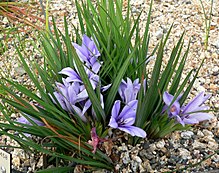| Babiana | |
|---|---|

| |
| Babiana sambucina subsp. sambucina | |
| Scientific classification | |
| Kingdom: | Plantae |
| Clade: | Tracheophytes |
| Clade: | Angiosperms |
| Clade: | Monocots |
| Order: | Asparagales |
| Family: | Iridaceae |
| Subfamily: | Crocoideae |
| Tribe: | Croceae |
| Genus: | Babiana Ker Gawl. |
| Type species | |
| Babiana plicata Ker Gawler
| |
| Synonyms[1] | |
| |
Babiana (/ˌbæbiˈænə/)[2] is a genus of geophytes in the family Iridaceae[3] with 93 recognized species as of March 2022[update]. The leaves consist of a stalk and a blade that are at an angle to each other. The leaf blades are entire, laterally flattened and pleated, and often hairy. Each individual flower is subtended by two hairy or smooth bracts that are green in most species. The outer bract is often the largest of the two. In most species the bracts have a dry, brown tip, but in a few species it is entirely green or entirely dry when flowering or the outer bract is translucent and has a papery texture. The inner bract (between the flower and the stem) is forked or split all the way to its base. Each flower is without a pedicel, with six tepals that are merged at their base into a tube and form a perianth that is mirror-symmetrical in most species, with three anthers implanted where the perianth tube widens and that are, in almost every species, clustered at one side of the style. The style has three branches that widen towards the tip and the ovary is inferior. Flowers occur in almost every conceivable colour, many have markings on some of the tepals, and few star-symmetrical flowers have a centre that strongly contrasts with the free part of the perianth.[1] The majority of these species are endemic to the west and southwest of South Africa, and southwestern Namibia, but one species occurs elsewhere in Namibia and South Africa and another species can be found in Botswana, Namibia, South Africa, Zambia and Zimbabwe.[1] The genus name is derived from the Dutch word baviaan, referring to the Chacma baboon, Papio ursinus, that consumes the corms of plants in the genus.[4] The genus is called bobbejaantjie in Afrikaans,[5] meaning small baboon.
- ^ a b c Goldblatt, Peter; Manning, John C. (2007). "A revision of the South African genus Babiana, Iridaceae, Crocoidae". Strelitzia. 18. South African National Biodiversity Institute, Pretoria, and Missouri Botanical Garden, Missouri: 113.
- ^ Sunset Western Garden Book, 1995:606–607
- ^ Kew World Checklist of Selected Plant Families
- ^ Manning, John; Goldblatt, Peter (2008). The Iris Family: Natural History & Classification. Portland, Oregon: Timber Press. pp. 175–178. ISBN 978-0-88192-897-6.
- ^ Manning, John (2007). Field Guide to Fynbos. Cape Town, South Africa: Random House Struik Ltd. p. 131.